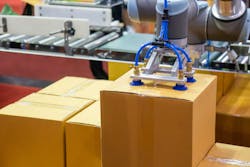Advances in pneumatic systems draw in more machine applications
The engineering field of pneumatics deals with the use of compressed air or gas to drive mechanical devices. From small tools and machines to substantial industrial automation systems, pneumatic systems have been used in a variety of applications. Pneumatic technology has recently advanced, making a wide range of machine applications more common. High power density, cost-effectiveness, simplicity in design, durability and safety are just a few of the benefits of pneumatics in machine applications. For applications that call for a balance of speed, power and accuracy, pneumatic systems are the best option because they can provide precise control of motion. The top machine uses for pneumatics include industrial automation, assembly lines, packaging and labeling.
When used in machine applications, pneumatics have many benefits. Pneumatics are excellent for applications that call for high power in a small space due to their high power density. Second, pneumatics are economical because of their reasonably priced parts and the frequently accessible compressed air or gas that powers them. Third, the straightforward design of pneumatics makes them simple to install, use and maintain. Fourth, pneumatics can function in a variety of temperatures and challenging environments. They are also very dependable and long-lasting. Finally, there is no chance of an electrical shock or environmental damage when using pneumatics. Pneumatics are a desirable option for numerous industries, including industrial automation, packaging, material handling and medical equipment, thanks to these benefits.
In a wide range of machine applications across numerous industries, pneumatic systems are employed. The best uses of pneumatics include assembly lines, material handling, robotics and automation, packaging and labeling equipment, auto manufacturing, food and beverage processing and medical equipment. The precise motion control, high power density and effective movement of loads provided by pneumatic systems make them the best choice for applications requiring precise and effective movement of goods and components. A preferred option for many industries, pneumatic systems are also secure to use and unlikely to pollute the environment as a result of spills or leaks.
When choosing pneumatics for machine applications, there are several factors to take into account. These considerations include the system's required force and speed, the operating environment, the noise level, energy efficiency, needed maintenance and cost. By carefully considering these factors, it is possible to select a pneumatic system that is best suited to the application's particular requirements while also maximizing performance and reducing operating costs.
For pneumatic systems to work properly in a machine application, several essential components are required. Pneumatic actuators, valves, compressors, fittings, tubing and accessories are some examples of these parts. While valves control the flow of compressed air, pneumatic actuators use compressed air to move parts of a machine. The compressed air required to power the system is produced by compressors, and fittings and tubing link the various parts together. To ensure the system runs as efficiently as possible, accessories such as filters, regulators, lubricators and pressure gauges are used. Understanding how each component works will help you choose the best ones for a particular machine application, ensuring that the system runs smoothly and effectively.
To fill and package bottles of different sizes, a bottling plant needs an effective system. A pneumatic system is used to address this need. The system uses a pneumatic cylinder as an actuator to move the bottles along the conveyor belt. To ensure even and steady movement, a pressure control valve controls the flow and pressure of compressed air into the cylinder. A variety of pneumatic fittings and tubing are also included in the system to link the parts together.
A number of pneumatic grippers engage as the bottles move along the conveyor belt to stabilize them while being filled. A system of directional control valves that control the grippers allows for precise positioning and gripping force. The grippers release after the bottles are filled, and they continue to move along the conveyor belt to the packaging station.
In a manufacturing setting, this system offers a reliable and effective method for filling and packaging bottles. The system can run quickly and reliably while also lowering maintenance and operating costs by utilizing pneumatic components. The system's modular construction also makes it simple to upgrade and modify it to suit changing plant requirements.
Pneumatic systems are extensively utilized in a wide range of machine applications, from heavy machinery to bottling plants. The ease of use, dependability, effectiveness and affordability of pneumatics are benefits. Pneumatic systems are adaptable and simple to upgrade or modify to meet changing needs. However, selecting the right pneumatic components and designing the system requires careful consideration of several factors, including the required force and speed of the system, the operating environment, noise level, energy efficiency, maintenance requirements and cost. It is possible to guarantee optimum performance and efficiency while reducing operating costs by carefully choosing the right components and designing the system to meet the specific needs of the application.
About the Author
Shawn Cox
Contributing Editor
Shawn Cox is a licensed master electrician/PLC programmer. He was co-owner/operator of Bobby Cox Electric for 15 years and is currently employed by BMW Manufacturing as an ESA. Contact him at [email protected].

Leaders relevant to this article:

